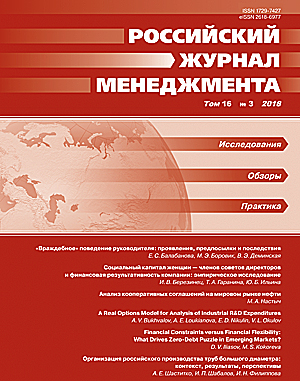Социальный капитал женщин — членов советов директоров и финансовая результативность компании: эмпирическое исследование
DOI:
https://doi.org/10.21638/spbu18.2018.302Аннотация
В современной практике корпоративного управления одной из наиболее обсуждаемых тем при анализе состава совета директоров (СД) является вопрос о включении в него женщин. Неоднозначное направление взаимосвязи между долей женщин в СД и финансовыми показателями деятельности компании, которое получают в эмпирических исследованиях, может объясняться не только различием в числе женщин-директоров, но и тем, какие женщины в него включены. В частности, тем, какой капитал женщины-директора привносят в компанию. Цель данной статьи заключается в том, чтобы выяснить, какой вклад социальный капитал женщин-директоров, выраженный множественными директорскими позициями, вносит в результативность деятельности компаний. Основываясь на динамическом подходе к понятию социального капитала женщин — членов СД, мы провели эмпирическое исследование на выборке публичных российских компаний за период с 2002 по 2010 г. и изучили особенности социального капитала женщин — членов СД. Полученные результаты позволили сделать вывод о том, что наличие множественных директорских позиций, занимаемых женщинами — членами СД в течение длительного времени, агрегирует и аккумулирует специфические профессиональные знания, навыки и опыт, повышающие ценность компании. В заключении статьи предложено обсуждение полученных результатов, определены направления дальнейших исследований.
Ключевые слова:
совет директоров, женщины в совете директоров, гендерное разнообразие совета директоров, человеческий капитал женщин — членов совета директоров, социальный капитал женщин — членов совета директоров, множественность директорских позиций
Скачивания
Библиографические ссылки
REFERENCES IN LATIN ALPHABET
Translation of references in Russian into English
Загрузки
Опубликован
Как цитировать
Выпуск
Раздел
Лицензия
Статьи журнала «Российский журнал менеджмента» находятся в открытом доступе и распространяются в соответствии с условиями Лицензионного Договора с Санкт-Петербургским государственным университетом, который бесплатно предоставляет авторам неограниченное распространение и самостоятельное архивирование.





